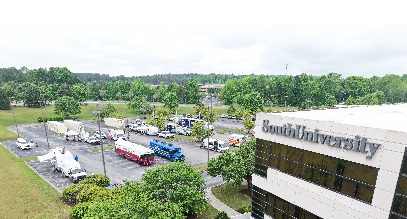Anesthesiologist Assistants serve an important role in healthcare and administer anesthetics for an incredible array of medical procedures, including trauma surgeries, neurosurgery, labor epidurals, cancer operations, orthopedics, complex cardiac procedures, and even organ procurement for transplants.
“AAs are a vital part of the operative team,” says Kristine Tindol, Program Director of South University’s Master of Medical Science (MMSc) in Anesthesiologist Assistant Program. “AAs even care for hours-old infants who require anesthesia for life-saving procedures almost immediately after they are born.”
Collaborating on the Anesthesia Care Team
Anesthesiologist Assistants (also known as AAs or CAAs for Certified Anesthesiologist Assistants) play an essential part of the anesthesia care team in hospitals. “When patients arrive for surgery, many of them may not realize that they have one physician anesthesiologist, who is a medical doctor, who may then be medically directing up to four other providers, including anesthesiologist assistants,” Tindol explains.
This care team model is not only cost-effective but also the safest model of anesthesia care, with AAs heavily involved in each case. From the start, the AA works with the patient – getting the patient from the preoperative holding area, answering questions and asking about health history. From there, the AA and anesthesiologist confer, and the team works together to get the patient safely to sleep.
“An anesthesiologist assistant has to be a good team player. The OR is a team environment. You're working with the surgeon, an anesthesiologist, the scrub technician, and the OR circulating nurse,” says Tindol. In the OR, the AA manages the airway and monitors patients’ vital signs, with many patients intubated and placed on ventilators throughout their procedures. Following the procedure, the AA extubates and wakes up the patient before bringing them to the recovery room.
Using Critical Care Expertise in the COVID Pandemic
During the COVID-19 pandemic, many surgeries have been postponed to protect patients and to allow organizations to allocate more workers and resources (like personal protective equipment or PPE) to caring for COVID patients. While some AAs continue to work on anesthesia care teams for things like trauma and gunshot wounds, appendectomies, and heart surgeries, many AAs are transitioning to intensive care units (ICUs) to support COVID patients.
“So many of an AA’s skills translate well to critical care. For the patients who are very sick and need to be on ventilators, AAs can not only manage the ventilators but are also working on intubation teams for this high-risk procedure to secure patient airways,” says Tindol. “ICU patients also need advanced monitoring techniques and medications, often with a central venous line, to help them through the illness. Ventilation and advanced monitoring are areas where we are well trained and able to assist critically ill patients in this time of great need.”
Giving Each Patient and Procedure Individual Attention
In every scenario, being an anesthesiologist assistant requires care and attention to detail. “There are so many small things that go on in surgery. You need to be able to keep track of what's happening with the surgeon and patient, with the procedure, and with the anesthetic,” explains Tindol. “You have to pull information from all of these different areas and process it correctly to make the best decisions.”
Outside of medical procedures, AAs also apply that same level of attentiveness and care in showing kindness and empathy to their patients, who are frequently nervous about their upcoming medical procedures.
“It is our job to comfort them and to assure them that we're there, that we will be their eyes and their ears, that we will speak up for them, and most of all that we will take them safely through this process,” says Tindol. “To help give the patient as safe of an experience as possible while undergoing the procedure and throughout their time in the perioperative period – that is our duty.”
In other words, every patient under the care of an anesthesiologist assistant has another person in their corner advocating for their health and rooting for their recovery, and that is something for which to be grateful.




